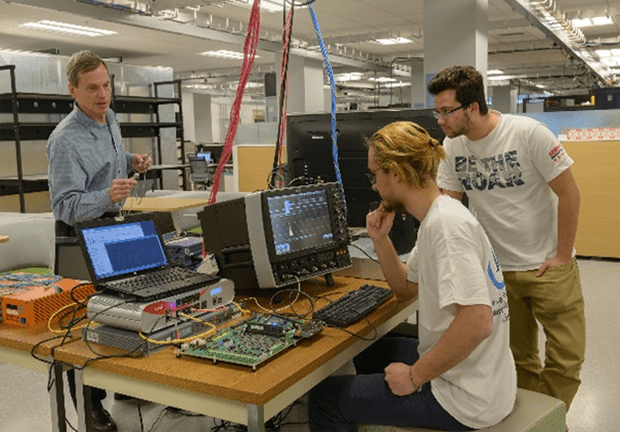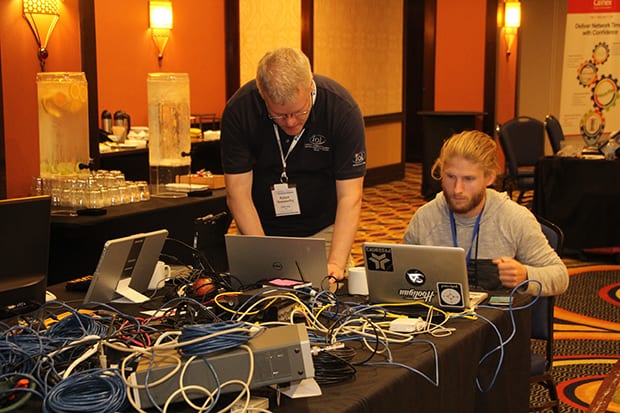Utilities deploying precise timing in their networks have an additional choice in evaluating solutions based on whether or not the devices are IEEE certified for compliance to the appropriate IEEE 1588 Power Profile. To reach this point, years of effort from the IEEE, International Electrotechnical Commission (IEC), National Institute of Standards and Technology (NIST), and the University of New Hampshire InterOperability Laboratory (UNH-IOL) have come together to enable this option now going through pilot testing.
The distribution of precise timing across common networking infrastructure is ubiquitous in many applications, including power, automotive, industrial, and telecommunications. Common underlying timing standards such as IEEE 1588 for Precision Time Protocol (PTP) have thus gained in popularity, as various PTP profiles of the IEEE 1588 address the market-specific needs. For the smart grid, standards development organizations such as IEC and IEEE have recently completed updates for their IEEE 1588 Power Profiles to aid utility companies in the specification of their timing networks.
How, though, does a utility or a supplier know if their product meets the expectations of the standard and its profiles? The NIST Smart Grid Program seeks to ensure that standards relevant to the smart grid have associated testing and certification programs to provide confidence to utilities that implementations conform to the requirements with appropriate oversight of an industry test program operator.
With the recent publications of the PTP Power Profiles, the IEEE-SA Conformity Assessment Program (ICAP) has established a path toward certification for the power industry. Through grant support from NIST, and review and assistance from a committee of experts organized by the ICAP, the UNH-IOL has produced the Test Suite Specification (TSS) test plan to govern the initial certification program. A committee of experts, known as the Conformity Assessment Steering Committee (CASC) includes representatives from NIST, UNH-IOL, IEEE-SA, the Oak Ridge National Laboratory, as well as utilities, such as Bonneville Power Administration and AltaLink.
Distributed energy resources such as solar and wind are just one example of the evolving grid. Such microgrids need to synchronize their inverters with the grid. Similarly, the use of synchrophasors to monitor grid health over a large geographic area continues to expand. Such Phasor Measurement Units (PMUs) require clock synchronization accuracy in microseconds to minimize errors in the phase-angle measurement. Fault detection tools benefit from precision clock synchronization to pinpoint transmission line faults to within hundreds of meters. Event data recorders similarly need to log in a common time base over large regions.
By way of these brief examples, precise time is used in today's smart grid to monitor the health of the current grid, enabling automation of control decisions in dynamic environments. In the event of fault, event logs will more rapidly find and remedy grid failures. For such reasons, utilities benefit from deploying certified equipment, allowing for the potential consideration of intelligent electronic devices from various suppliers with greater confidence in their underlying functionality and interoperability.
To this end, the UNH-IOL's IEEE 1588 Testing Service has developed the TSS, as well as a conformance test tool to aid in automating the required validation. Working closely with ICAP and NIST, the UNH-IOL is also hosting a pilot program that is currently open and continues to welcome participants (Figure 1). These tests are designed to validate the conformance of an implementation to the IEC/IEEE 61850-9-3 standard, and to the additional requirements of the IEEE C37.238 standard, if supported by the device under test.
 |
| 1. Student test technicians running IEEE 1588 testing at the University of New Hampshire Interoperability Laboratory (UNH-IOL). Courtesy: UNH-IOL |
As the pilot program for the power profile certification testing proceeds through the months ahead (Figure 2), participants will gain early access to certification test results, and actively validate and shape the refinement of the TSS. Upon completion of the pilot program, the IEEE-SA's IEEE 1588 Power Profile Certification Program will accept applications for passing products to receive the IEEE certification mark. Through participation in the IEEE program, the industry can provide feedback for future needs, clarifications, and drive change, all with the goal of better serving the needs of utilities.
Those not well-versed with these standards may ask: "What is this for? What problem does it solve?" Today, many devices can receive very accurate time from GPS; however, GPS is less reliable indoors, can be subject to jamming and spoofing, and every device on the network cannot be connected to a GPS antenna. Distribution of time based on communication protocols, typically across fiber or copper Ethernet links, are low-cost methods to propagate time from a source, be it GPS, time delivered to a substation via the IEEE 1588 Telecom profile, or other methods. Sub-microsecond time synchronization by all devices in the network is readily attainable with relatively low-cost hardware today. This enables the accuracy sought and needed in the PMU, traveling wave fault location, and related applications mentioned above.
To allow for flexibility of deployment, the IEC and IEEE cooperated to develop the 61850-9-3 standard, a profile of IEEE 1588 for power utility automation. All "Power Profile" devices must comply with this standard. The IEEE Power Substation Relay Committee (PSRC) extended these requirements with the IEEE C37.238 standard, which adds requirements to convey such information as the accumulated "time inaccuracy" introduced by the network as reported to the application in the receiving end-stations to then act accordingly if the time delivered is inadequate for continued operation. This is a prime example of the growing need throughout precise-timed environments for improved monitoring of the quality of time, and the ability of end applications to infer the quality of the measurement timestamps.
The time quality delivered to a node must be monitored to provide greater reliability to the overall health of the grid. Regarding security, time itself can be an attack vector. Consider again the relative ease by which GPS can be jammed over spans of kilometers from relatively low-cost transmitters, typically used to mask movements of truckers or the like. The negative impacts of bad time can and will have ever greater impact, be this a result of faulty or non-conformant equipment, or malicious actors.
While the initial TSS is focused on basic conformance to the relevant standards, there is certainly a need to continue to expand the scope of the test suite to provide further assurance to utilities deploying this technology. Such expansion may include the test and validation of the IEEE 1588 Telecom profiles, as used by utilities to distribute time over large distances, or the independent validation of redundancy and resiliency standards such as High-availability Seamless Redundancy and Parallel Redundancy Protocol (HSR/PRP) defined by IEC 62439-3.
Through third-party, neutral, and independent validation of such protocols, utilities can gain further confidence in these technologies without the burden of themselves validating the minutiae of these standards. With the coordinated input and review from the IEEE-SA's Conformity Assessment Program, advancing the certification needs of the industry to further enable market adoption and implementation, the deployment of a conformant and interoperable smart grid can be accelerated. Certification not only drives such confidence and adoption but helps root out issues before they are found in the field. The UNH-IOL brings three decades of network test experience to this problem and welcomes participants from all aspects of the industry to help drive the success of this program.
–Bob Noseworthy is Chief Engineer with the UNH-IOL. In this role, he advises on and leads various technical development activities such as time sensitive network-related testing services, Avnu Alliance certification, automotive networking, industrial networking, ProAV networking, and IEEE 1588/PTP test services. He is also closely involved with TSS development for IEEE 1588 Power Profile, the continued evolution of 802.1's Time Sensitive Networking standards (formerly Audio/Video Bridging,) and their continuously evolving use in automotive, industrial, power and telecom spaces.

